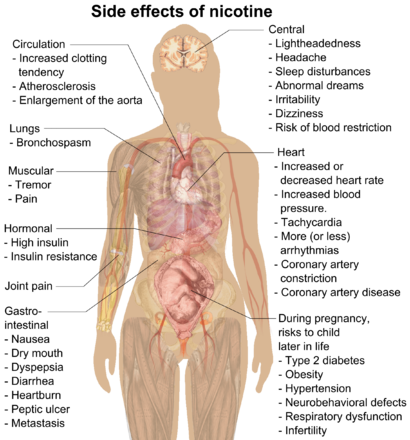Electronic cigarette facts for kids
An electronic cigarette (or e-cigarette) is also called a vape. It's a device that looks like it's smoking tobacco. It has a special part called an atomizer, a battery, and a place to hold liquid. Instead of smoke, you breathe in vapor. Because of this, using an e-cigarette is often called "vaping".
The atomizer is a heating element that warms up a special liquid. This liquid is called e-liquid. When heated, it quickly turns into a mist of tiny drops, vapor, and air. This vapor mostly contains propylene glycol and/or glycerin. It usually also has nicotine and flavoring. The exact mix of chemicals in the vapor can change. It depends on things like how someone uses the e-cigarette.
E-cigarettes start working when you take a puff or press a button. Some e-cigarettes look like regular cigarettes. Most types can be used many times.
Nicotine is very addictive. This means people can become physically and mentally dependent on it. Scientists are still learning how harmful e-cigarettes are over a long time. It's hard to study because many people who vape also smoke regular cigarettes. E-cigarettes haven't been around long enough to know for sure.
Vaping is probably less harmful than smoking. However, it can still cause harm. E-cigarette vapor has fewer toxins than cigarette smoke. But it can have small amounts of harmful things not found in cigarette smoke. E-cigarettes with nicotine can help people stop smoking. But they haven't been tested as strictly as other ways to quit smoking.
How E-Cigarettes Affect Your Health
Using e-cigarettes can increase your risk of certain lung problems. These include chronic obstructive pulmonary disease (COPD), asthma, and chronic bronchitis. It can also increase the risk of emphysema.
Some common but less serious adverse effects are stomach pain, headaches, and blurry vision. You might also feel irritation in your throat and mouth. Other effects include throwing up, feeling sick, and coughing. Nicotine is addictive. It can also be harmful to unborn babies, children, and young people.
Are E-Cigarettes Safe?
Experts don't fully agree on the risks of using e-cigarettes. There isn't much information about how safe they are.
The risk of serious health issues from vaping might be similar to using smokeless tobacco. E-cigarette vapor does not contain tobacco. It also doesn't involve burning anything. This means users might avoid some harmful things found in tobacco smoke. These include ash, tar, and carbon monoxide. However, using e-cigarettes, with or without nicotine, is not completely risk-free. This is because we don't know their long-term effects.

The e-liquids can have different levels of harm to cells. Sometimes, unwanted chemicals have been found in the liquid. Metal parts of e-cigarettes can also get into the e-liquid. This can add tiny metal pieces to the liquid. Many chemicals, like carbonyl compounds such as formaldehyde, can be made by accident. This happens when the nichrome wire (the heating part) touches the e-liquid and heats up.
Another chemical found in e-cigarettes is ketene. When you breathe it into your lungs, it can damage lung tissue. This makes it harder for your lungs to work properly. It can cause shortness of breath. This might lead to other health issues. E-cigarette users who use devices with nicotine are exposed to its possible harmful effects.
Nicotine is linked to heart and blood vessel problems. It can also cause other health issues.
E-cigarettes create vapor with very tiny particles. Most of these particles are super small. The vapor has been found to contain propylene glycol, glycerin, nicotine, and flavors. It also has small amounts of toxicants, chemicals that can cause cancer, and heavy metals. Tiny metal particles and other substances can also be in the vapor. Many cancer-causing compounds have been found in e-cigarettes. These include N-Nitrosonornicotine (NNN) and N-Nitrosoanatabine (NAT). All of these are known to be harmful to people.
E-cigarette vapor might contain harmful chemicals not found in tobacco smoke. If a parent uses e-cigarettes, it could lead to health risks for their children.
Impact on the Environment
E-cigarettes that are not reusable add to the problem of electronic waste. This waste can be dangerous for people and animals. If they are not thrown away correctly, they can release heavy metals, nicotine, and other chemicals. These come from the batteries and any leftover e-liquid.




